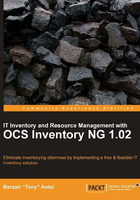
Getting ready for the OCS-NG installation
The OCS-NG management server encloses all of the four server roles that our inventory solution entails. It is the centralized heart of the inventory. In this chapter, we're going to look through the necessary steps to prepare our system in order to fulfill the general requirements of running OCS-NG management server. As it is a cross-platform project, we will cover the installation on specific Linux flavors and on a Windows server operating system.
The actual installation process is console based on Linux environments. It is verbosely logged, and the steps can be easily followed. It is straightforward. On Microsoft Windows operating systems, there is a de facto standard Win32 setup-like installation wizard.
OCS Inventory NG runs on top of the popular Apache web server, using MySQL's InnoDB engine and the PHP server-side scripting language. In order to install the OCS-NG management server, the system must have these prerequisites installed and configured.
On Linux distributions, we'll look into a brief overview of the steps involved for installation. This checkup helps us to refresh our memory. Under most circumstances, should you desire to install OCS-NG on a Linux server, this suggests that you are familiar with working in Linux/Unix environments. Therefore, setting up basic server roles should not cause you any problems.
There is an integrated pack that sets up all of the components we must have for a fully functional web server. This package is available for Windows, Linux, Solaris, and Mac OS X operating systems. It's called XAMPP. The developers of OCS-NG thought about making the process seamless on Windows machines. The Win32 installation kit of OCS-NG includes this integrated pack and sets up the prerequisites during the setup process.
Regardless of which platform we choose to install the OCS-NG management server on, the next step is the initial configuration. After fiddling with a few security pointers, we can finally declare that our server is pretty much ready for further action. Thus, our objective is met.
This is our action plan for this chapter!